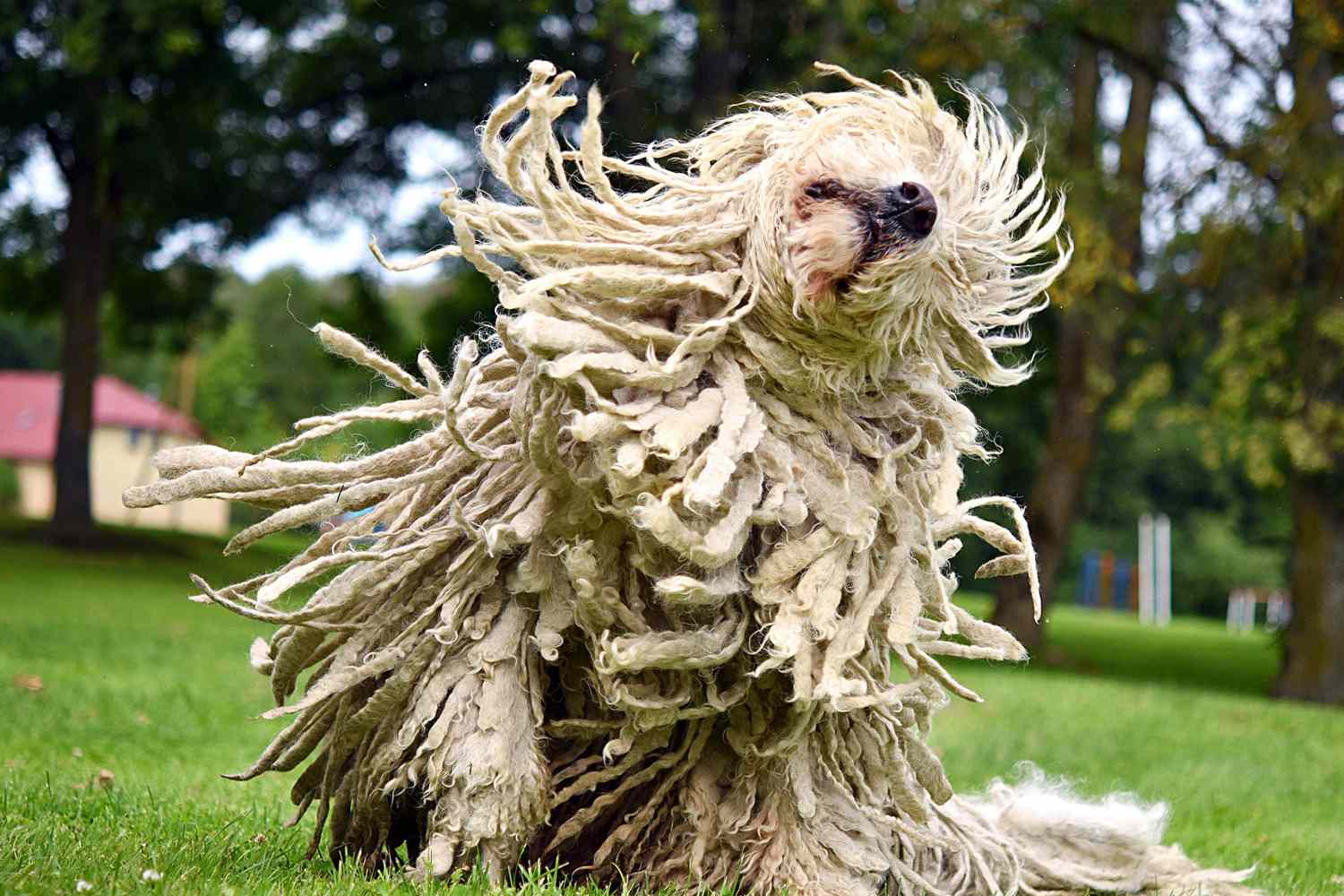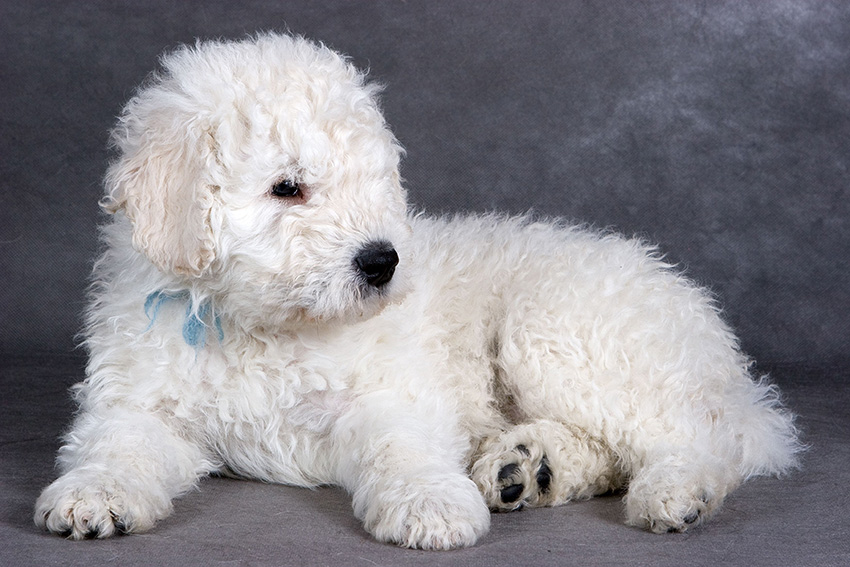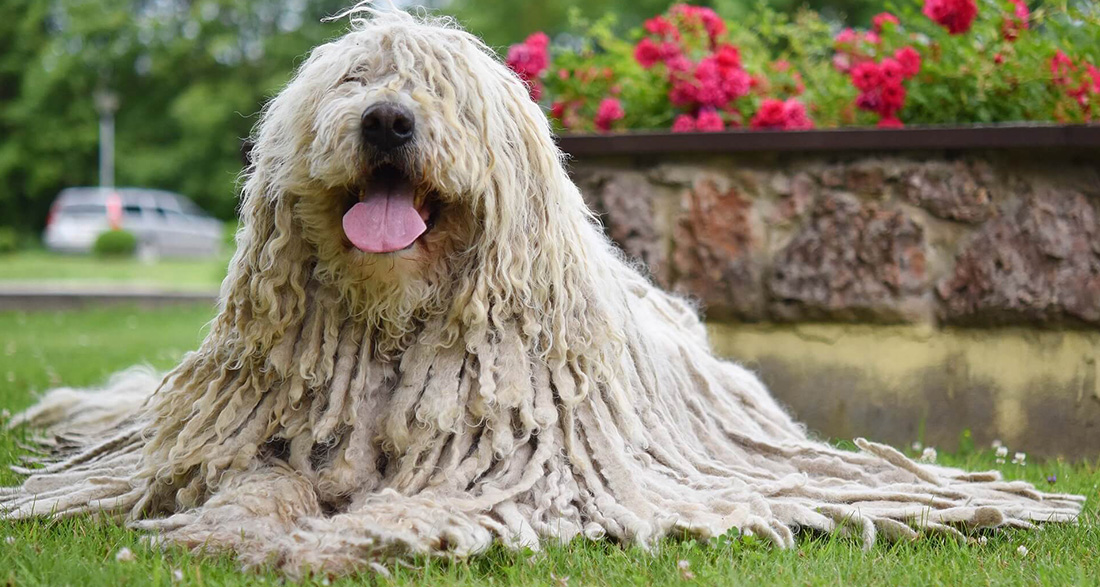The Komondor is a truly unique dog. Its fur has a peculiar structure, hanging in thick strands around its body. Many Komondors are so shaggy that you can only vaguely guess their faces. But character-wise, too, the Hungarian shepherd dog stands out from its counterparts. Stubbornness, self-assurance, and sovereignty combine to form a strong overall personality.
History of the Komondor
The Komondor is a Hungarian shepherd dog, with different theories existing regarding its geographical and genetic origins. However, genetic analysis now seems to indicate that the distinctive dreadlocks were not always present but are due to a genetic defect. Although there are records of the Komondor dating back to the 9th century, it wasn’t until a thousand years later that it developed its shaggy coat; previously, its fur was smooth and rough.
Genetic analysis has revealed a relationship with the Hungarian Kuvasz. The presumed descent from Asian breeds was disproved in the same step. Since 1954, the Komondor has been recognized by the FCI (Fédération Cynologique Internationale). Within the United States, breeding is conducted according to the applicable breed regulations and planned coordination by the Club for Hungarian Shepherd Dogs.
Breed Overview
GROUP: Working
HEIGHT: 27 1/2 inches, minimum (male); 25 1/2 inches, minimum (female)
WEIGHT: 100 pounds or more (male); 80 pounds or more (female)
COAT: Long, corded hair
COAT COLOR: White
LIFE SPAN: 10 to 12 years
TEMPERAMENT: Steady, affectionate, fearless, independent, calm, gentle
HYPOALLERGENIC: No
ORIGIN: Hungary
Nature and Character
The Komondor has a strong protective instinct and is always alert. If a stranger enters its territory, it will bark forcefully. However, it does not display this behavior towards its owner or outside its own home. Nevertheless, it initially behaves very reserved and neutral towards new acquaintances. Only the closest family members get to experience its calm and trusting nature.
| Affection Level | High |
| Friendliness | Medium |
| Kid-Friendly | Medium |
| Pet-Friendly | Medium |
| Exercise Needs | High |
| Playfulness | High |
| Energy Level | Medium |
| Trainability | High |
| Intelligence | High |
| Tendency to Bark | High |
| Amount of Shedding | Medium |

Acquisition of a Komondor
If you are seriously interested in a Komondor, you need to know how to obtain one. Since the Komondor is a rare breed in this country, acquiring one can be complex and time-consuming. In the following section, you will learn about the criteria for choosing a suitable breeder and what else to consider when making a purchase.
What should I consider when buying?
To ensure the genetic lineage of your puppy, you should trust selected breeders rather than internet sellers.
These advantages result from this:
- The assurance of receiving a purebred Komondor and not a mixed breed.
- The parent animals are healthy, and the puppy has also been medically cared for.
- The dreadlocks are selectively chosen by a responsible breeder so that they do not bother the Komondor.
- Breeders socialize the offspring very early, which is a valuable basic education for the stubborn Komondor.
It is important that you personally get to know the puppies and get an impression of the living conditions. Additionally, at least the mother should be present. Around 25 Komondor puppies are born in the United States annually. Therefore, you may need to put your name on a waiting list if you want one of these rare dogs. Komondors are rarely found in U.S. animal shelters; however, there is the possibility of obtaining a puppy from European countries.
However, there is no guarantee of the purity of the breed or whether the breeding conditions are appropriate. A good seller can also be recognized by the fact that they inquire about the buyer and only release their wards to a suitable home with a caring family.
Development and Training of the Puppy
The Komondor is a dog that traditionally cooperates with humans to assist them in herd protection. Therefore, he is quite trainable and can be well-educated.
However, the Komondor also has a mind of his own. He will only follow his owner’s command if it aligns with his own reasoning.
Therefore, dog experience and assertiveness can be advantageous in dog training. In order for the former watchdog to live well within a family system, you should socialize him from puppyhood. This training step is not a flaw of the Komondor but an essential foundation for the education of any dog.
How to Care for a Komondor?
The Komondor is a robust all-weather dog that can thrive outdoors. Weather changes, rain, and cold phases do not bother him at all. In some European countries, the Komondor is used as a livestock guardian and watchdog. At the same time, he is a great family dog who can adapt to apartment living and the usual family routine.
Once well integrated into the family, he accompanies them everywhere without causing any negative issues or disturbances. In the United States, the Komondor is not classified as a dangerous dog breed, but in Switzerland, it is. There, it is seen as a potential danger, which is why keeping them is subject to strict regulations.
Activities with the Komondor
The Komondor is a low-maintenance animal that doesn’t need additional activities aside from its protective duties. If provided with a large plot of land, he will find his own areas of activity. Nevertheless, he still enjoys joining his family for walks. In apartment living, the dog owner must be a bit more creative to prevent boredom.
Although the Komondor does not demand specific entertainment, you should at least integrate him into family life by spending time together and allowing him to be near you. The heavy curls restrict the Komondor’s mobility, making him neither enthusiastic nor suitable for most dog sports. However, some individuals may enjoy agility. So, whether the dog is sports-oriented depends not only on the breed but also on individual character traits.

Health and Grooming
There are no breed-specific diseases in the Komondor, although there is an increased risk of hip dysplasia. However, this is not related to the breed but rather to the dog’s size.
However, grooming the Komondor’s coat is particularly unique and can be very laborious and time-consuming:
- Dirt can easily get trapped in the long cords of hair, so you should regularly check the coat for any large foreign objects.
- Neither Komondor puppies nor adult dogs should be brushed. To allow the cords to develop their typical appearance, simply run your fingers through the coat. Once the cords have formed (around the first year of life), you can gently separate them. Each cord should hang separately to prevent matting. Ideally, this finger grooming should be done every day.
- You can help your Komondor by trimming its coat in certain areas. This includes the inner thighs, genital and anal regions, toes, inner ears, as well as the eye and mouth areas. Trimming the coat helps prevent (skin) diseases, improves hygiene, and enhances mobility. Trimming around the eyes also expands the field of vision, which can be greatly obstructed by pronounced cords.
- Avoid bathing your Komondor, as drying afterward can take several hours, if not days. Instead, simply wipe with a damp towel to remove surface dirt and prevent unpleasant odors. However, you may not be able to completely prevent odor buildup and deep-seated dirt.
Interesting Facts
The cords of the Komondor were not always so pronounced but are the result of deliberate breeding. Unfortunately, the selection for more pronounced cords progressed to the point where the dog is hardly useful for its original work as a herding dog, as its movement is severely restricted. Additionally, the Komondor’s characteristic coat presents a problem in social interactions because it obscures its facial expression. Thus, it is difficult to discern its mood and respond appropriately.
Do you have a Komondor or are you planning to get one soon? Tell me more in the comments!


